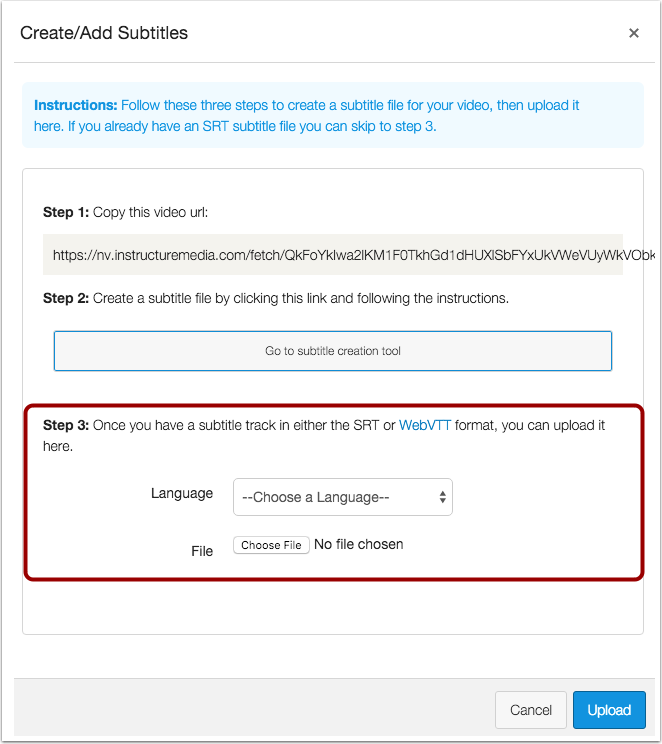DIY Captioning Canvas Videos
When captioning, we've found the process of creating quality captions to be easier if we did our transcription and initial caption formatting in Word. Transcripts should record verbatim what is said, identify speakers, and identify important sound effects. It's best if the transcripts are as grammatically correct as possible too.
- Speaker identification goes in parentheses ( ).
- Sound effects go in brackets [ ].
- Corrections to audio should be in brackets [ ].
- Interruptions should be indicated by -- or —.
Once the transcript is complete, we put the entire transcript into a monospace font such as Courier New and then adjusted the document margins so that there were only 32 characters per line (which is part of DCMP's captioning Links to an external site. requirements). You can copy-paste the string of numbers below into your word document, give them the same font and size as the rest of the document, and then place the right margin just after the 32.
02 05 08 11 14 17 20 23 26 29 32
From there, use the enter key once to create new lines within a caption and use the enter key twice to create new captions. By the end, your document should look like this:
Hi, I'm a single-line caption.
This is a two-line caption.
See? Here's the second line.
This is a third caption,
and it also has two lines.
When subdividing the transcript into this format, do your best to follow these DCMP Links to an external site. rules to make reading easier (particularly the first two):
- Unless one of the sentences is short (like one or two words) don't end one sentence and start another on the same line.
- Do not end a line or caption on a conjunction (For, And, Nor, But, Or, Yet, So).
- Try to not split people's names or titles across lines or captions.
- Try to not have modifying words on one line or caption and the word it modifies on another.
- Try to not split prepositional phrases across lines or captions.
- Try to not have auxiliary verbs on one line or caption and the verb it modifies on another.
Once finished, save the document as a Plain Text or .txt file. If a File Conversion window appears, set the text encoding to Other and then Unicode and check the Allow character substitution box (If you don't, you may need to replace apostrophes, quotation marks, and some additional punctuation later).
After that, find the video within Canvas. Do not enter editing mode. Click on the video to open the player, click the CC button (1) in the lower right and then Upload subtitles.

In the pop-up that appears, copy the video URL (1) then click the Go to subtitle creation tool button (2).

A new browser tab or window will open to Amara.org. In the field provided, paste the URL (1) then click the Begin button (2). This will navigate you to a new page.

On the new page, in the middle of the sidebar that's to the left of the video player, click Add a new language!

A pop-up will appear where you need to indicate the language of the audio and the language of your captions. After you click Continue, you'll need to log into or create an Amara account. Once you've logged in, you will finally be in the Amara caption editor. The editor is divided into six panels. At the top right of the middle bottom panel, there is a wrench icon which controls the Tools menu.

Open the Tools menu then select Upload subtitles. A pop-up will appear with information about acceptable file formats. Click Choose file then select the .txt file you created previously. After the file has been set, click the Upload button.
The transcript will appear in the bottom middle panel. If you used the Enter key correctly when creating the transcript, each chunk of text that had been separated by a blank line will appear in its own box in that bottom middle panel. If you have only one tiny box or a handful of boxes with a lot of text crammed into them, then you will need to fix your .txt file and reupload it.
Once you're confident that the bottom middle panel reflects the work you did in the .txt file, go to the top right panel and click the Set Timings button. Next, use the controls listed in the top left panel or use your mouse and the timeline that appears between the top and bottom rows of panels to set the timings.
Make sure to have a caption at the very beginning of your video (even if it says [silence] or [music]). Also, try to make your captions appear within half a second of when the corresponding sound starts.
Video: Amara Syncing Process
Links to an external site.
How to Sync Captions - Written instructions Links to an external site.
Once you have set the timings, click the Start Reviewing button in the top right panel. Play the video and check your work. Also look in the bottom middle panel for red exclamation marks on the right side of caption boxes. These exclamation marks can mean that there are too many lines in a single caption, too much text on a single line, or that the duration of the caption is too short to be read. Out of the three, the last should be the most common for you. To correct the reading rate error, play with the caption duration. You may need to stretch the earlier mentioned 1/2 a second rule to make it work. If the speech is too fast for there to be any adjusting, you can edit the caption to summarize what's being said.
When finished reviewing, click the Complete or Publish button in the top right panel. This will bring you back to the video page.
Now, you'll need to download the caption file. In the sidebar to the left of the video, below Language, select the language of captions you've been creating (generally, this will be English) (1). In the top right of the Subtitles tab and to the left of the Edit Subtitles link, click the Download drop menu (2). In the drop menu, select SRT (3) then save the file.
Next, go back to Canvas, find the video, click play, click the CC button, and click Upload subtitles. Use the bottom half of the pop-up to tell Canvas what language your captions are in and what caption file it should upload from your computer.

Click Upload. Then play the video to make sure that the correct caption file had been added. If it has, you're done.
Return to Videos Should Have Captions.
Guides
Illustrated Guides
- How do I create a caption file using the subtitle creation tool? Links to an external site.
- How do I add captions to new or uploaded videos in Canvas? Links to an external site.
- How do I upload subtitles and transcripts? - Amara Guide Links to an external site.
- Starting a Transcript - Amara Guide Links to an external site.
- Syncing a Transcript - Amara Guide Links to an external site.
Last Updated Fall 2016